Using Other Electronic Sources
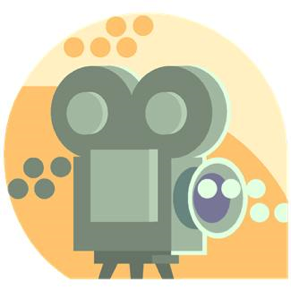
Source: Reel-to-Reel Camera, Microsoft Office clip art
Using video sources
Video clips, television shows, and movies can be legitimate sources. If you did the lesson “Generating Ideas and Questions about a Research Topic,” you might remember that I used the preview trailer for the movie Food, Inc. as a resource to begin crafting my research question. Many speeches, interviews, and news events have been preserved on video. For example, if you are writing a research paper about Dr. Martin Luther King Jr., you might want to view his “I Have a Dream” speech. If you are writing about Shakespeare’s Romeo and Juliet, you might want to watch movie versions of the play. Video is endlessly useful as a source.
Finding video
Let’s talk about a few places you can find appropriate video sources:
- The library: Your school library, the public library, or a local college or university library is a great place to find video. The video they have is recorded in the electronic catalog just like a book would be. Some libraries have streaming video available, which is video that you can watch on the computer without checking out a DVD or video cassette. Many library catalogs allow you to search by media type; that is, you can search for video only. When searching for video at the library, enlist the help of your librarian.
- The Public Broadcasting System: PBS.com is a great research site for video of significant historical and news events, science and nature topics, and arts and culture topics. At PBS.com, you can find video on many subjects including Hurricane Katrina, Martin Luther King Jr., and World War II.
- The History Channel: History.com has online video about topics such as the American Civil Rights Movement and the Space Race.
- Google Videos: Google.com has a search category for video. I typed our earlier search term ["tobacco AND teenagers – laws"] and found almost 300 videos from across the Web dealing with this topic.
Recording your video sources
Just as you do with your print and other online sources, you need to add any video you use as a source to your working bibliography. For video clips, record the following:
- Description or title of the video clip
- Date of video clip
- Title of Web site (if from Web)
- Name of library (if from library)
- Date viewed
- Web address (URL)
- Your impressions of the clip as useful for your paper
For movies, record the following:
- Title
- Director
- Performers (if you are discussing them in your paper)
- Film studio or distributor
- Year released
- Your impressions of the movie as a source for your paper
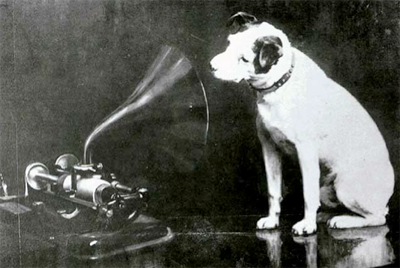
Source: "Nipper" listening to phonograph, Francis Barraud, Wikimedia Commons
Using audio clips
Just like video, audio can be a great source for your paper. Some historic events were recorded and archived in audio format that cannot be found as video because they happened before moving pictures. Also, many interviews and news programs are broadcast on radio. Of course, musical recordings can be used as sources as well. For example, if you are writing a paper about the opposition to the Vietnam War, you might use lyrics from protest songs as a source.
Finding audio clips
- NPR.com: This is the Web site for National Public Radio. NPR broadcasts interviews with politicians, artists, musicians, and writers daily.
- American rhetoric: Americanrhetoric.com/speechbank.htm has audio and video speeches, lectures, and sermons from historical figures such as Franklin D. Roosevelt, Martin Luther King Jr., John F. Kennedy, Malcolm X, and Ronald Reagan.
- Search engines: Google and Yahoo! searches of your keywords with ”+audio” result in many audio clips.
Recording basic information for audio sources
Any audio you use as a source should be added to your working bibliography. For audio clips, record the following:
- Creator (if available)
- Description or title of the audio clip
- Date of audio clip
- Title of Web site (if from Web)
- Name of library (if from library)
- Date you listened to the audio
For songs, record the following:
- Artist
- Song title
- Album title
- Date of release
- Record label or distributor
Let’s practice what we’ve learned about finding video and audio clips. Answer the questions below using your notes. When you’re finished, check your understanding to see how you did.
- Go to www.americanrhetoric.org. Find the list of Top 100 Speeches. Whose speech is ranked number seven, and what is the title?
- Go to www.google.com. Click on “Video” Search for “tobacco AND teenagers AND advertising.” What is the name of the video on the site www.go.abc.com?
- Go to www.pbs.org. Click on “Video” at the top of the page. Describe what you find on the page.
- Go to www.npr.org. The acronym NPR stands for National Public Radio—but what other kinds of media are available on this website?
- Go to www.history.com. Search for Anne Frank. Watch the video “This Day in History: 08/04/1944 – Anne Frank captured” from the day she was discovered. Many years later, in 1977, what happened on the same calendar day?
Sample Responses:
- Malcolm X, ”The Ballot or the Bullet”
- "Do Point-of-Sale Cigarette Ads Work on Teens?"
- A page dedicated to videos that have been featured on PBS that are available for download.
- Video and articles in addition to audio recordings of radio broadcasts
- President Carter created the Department of Energy.
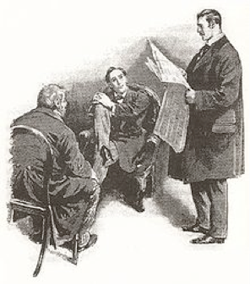
Source: From "The Red-Headed League," Sidney Paget,
Wikimedia Commons
With so much information available online, it is easy to think that print sources are obsolete. However, this is simply not true. Only a fraction of all books currently being published are available in an electronic format, and even fewer older books are available in an electronic format. Also, not all articles you need will be available online. Sometimes you will need to hit the stacks and find a book if you want to write a good paper.
Finding print articles
Since we already learned about finding articles in a database, let’s talk about finding articles that aren’t available in full text online. If you’ll remember, sometimes your database search results will include a link that says, “Check Linksource for full text.” When you click that link, you go to a page that shows where to find the article. Sometimes there’s a new link to another database that has the full-text article, but what do you do if your library doesn’t have access to the database? What if the article isn’t available anywhere online? If you really need the article to complete your research, there are other ways to find it.
Let’s look at a result from our search for “tobacco AND advertising AND teens.”

Source: MAS School – Ultra Search, EBSCO
This article deals with exactly what we are researching! Let’s click the title to read the abstract, or summary, of the article.
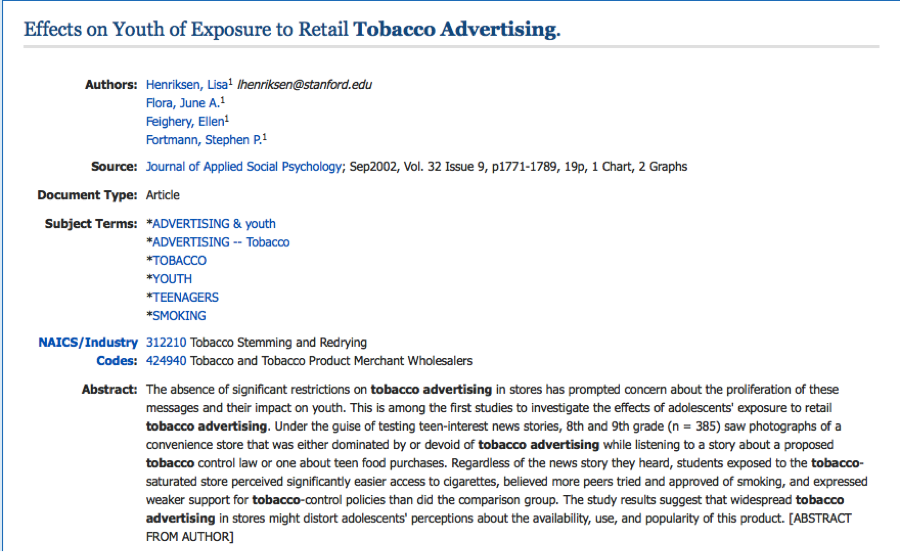
Source: MAS School – Ultra Search, EBSCO
The abstract says that this article is about a study dealing with the effects of advertising tobacco to teens. We definitely need to read this article. First, I am going to print this page. If printing is not available, I will write this information so that I can find it:
- Date (Sep 2002)
- Volume (32)
- Issue (9)
- Page range (1771–1789)
If we go back to the results page, we will see a line at the bottom of the entry that says “Notes: Available at Alkek Library.” This is the name of my library. Now I click the link that says, “Check LinkSource for full text,” and I get a screen that looks like this:
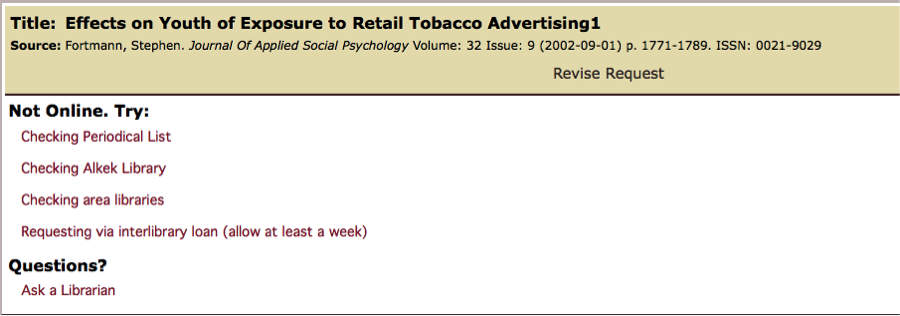
Source: MAS School – Ultra Search, EBSCO
So, this article is not available online. Each one of those links below the title gives me a way to find this article. If I click “Checking Alkek Library,” my library, I get a screen that looks like this:
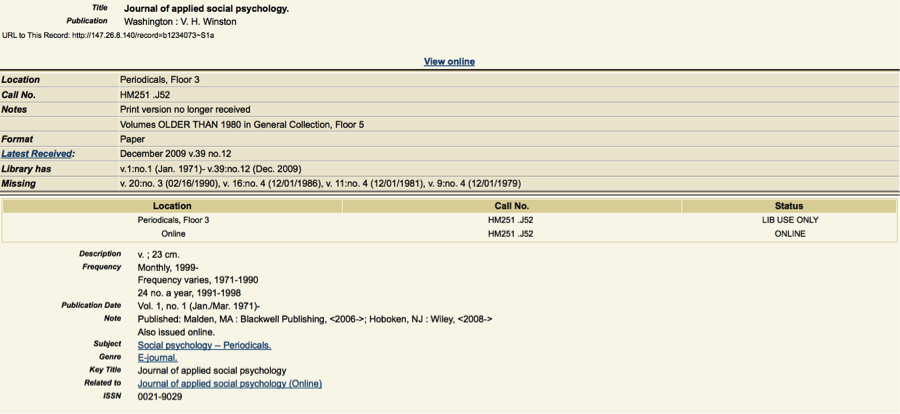
Source: MAS School – Ultra Search, EBSCO
This is an entry from the library’s catalog. If I look at the field titled “Location,” it tells me that the bound print editions of this journal are available on my library’s third floor. If I look at the field “Library has,” it tells me that the library has volumes 1–39 of this journal. According to my notes, I need volume 32. The last thing I need to do is write down the information from the field “Call No.,” which has the call number for this material. Now I can go to the third floor and find my article. If you need help finding something, don’t hesitate to ask librarians. It’s their job to help you, and they love being asked.
What if this article weren’t available at my library? What if the volume I need is listed in the field “Missing”? In that case, I would definitely want to go to the librarian for help. Library staff can help me search the catalogs of area libraries or even get the article through an interlibrary loan. The Interlibrary loan program allows you to get books or articles sent to your library for your use.
Recording your source
As always, once we find a print article we want to use for our paper, we need to add it to our working bibliography. Record the following for your article:
- Author (primary author only is OK at this stage)
- Title
- Publication
- Date of publication
- Volume, issue, and page range
- Your impressions of the source or a summary
For this article I would write the following:
- Henrickson, Lisa (for the real bibliography, I would write all the authors)
- “Effects on Youth of Exposure to Retail Tobacco Advertising”
- Journal of Applied Social Psychology
- Sep 2002
- Volume 32, Issue 9, p 1771–1789
- This article is exactly what I need.
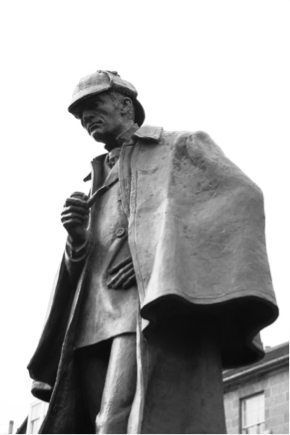
Source: Statue of Sherlock Holmes in Edinburgh,
Siddharth Krish, Wikimedia Commons
As we discussed earlier, when you can find so much information on the Web or in an online database, books seem almost obsolete. Books, however, cover subjects in much more depth than an article or Web site can. Books are very important for our research, especially when we are looking for background information. For example, if you were assigned to write a research paper about Billy Budd, you might want to read a biography about the author Herman Melville and his time at sea or read his other novels about sailors and the sea.
Finding books
Since most library catalogs are available online, finding books in a library is relatively simple if you know how to create an effective search.
The library catalog can be searched in a few ways: author, title, subject, and keyword. Author and title are the easiest searches to perform. If you know the author’s name, simply type it into the search bar and click “Search.” The same goes for searching by title, but be sure everything is spelled correctly.
Searching by keyword
We’ve looked for articles and Web sites using keywords. We can look for books using the same technique. If we do a Boolean keyword search on “tobacco AND advertising AND teenagers,” we get a good list of books that we can use in our research.
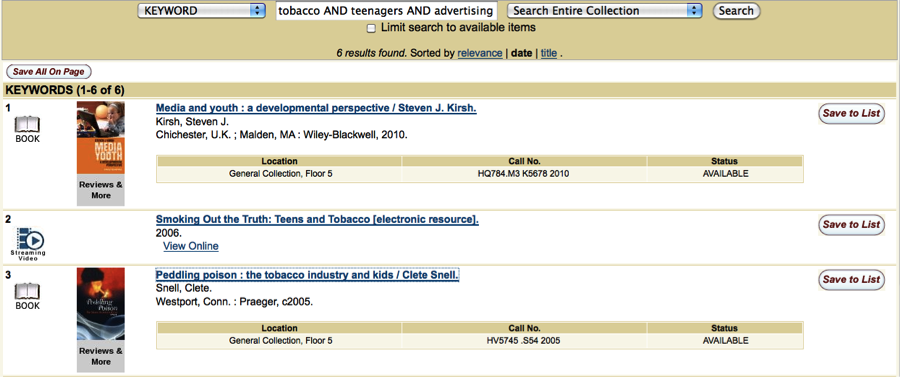
Source: MAS School – Ultra Search, EBSCO
The third result is a book that looks like it would be good for background research. We can learn from the title that the book will probably be about how media (television, movies, magazines, advertising, etc.) shapes development. The third entry, however, speaks to the heart of what we have been trying to find. From the title, we can tell that this author believes that advertising tobacco to teenagers has a negative effect. We should print this result page or write down the title, author, and call number and go find the book.
What if those keywords didn’t retrieve any relevant results? Does this mean that there are no books in the library that we can use for our paper? Not necessarily. It might mean that we need to choose different keywords or perhaps search by subject.
Searching by subject
If we know we want to write a paper about tobacco use but don’t know what aspect to write about, we can type the word “tobacco” into the subject search field and browse through the related subjects. Here’s what a subject search on tobacco looks like:
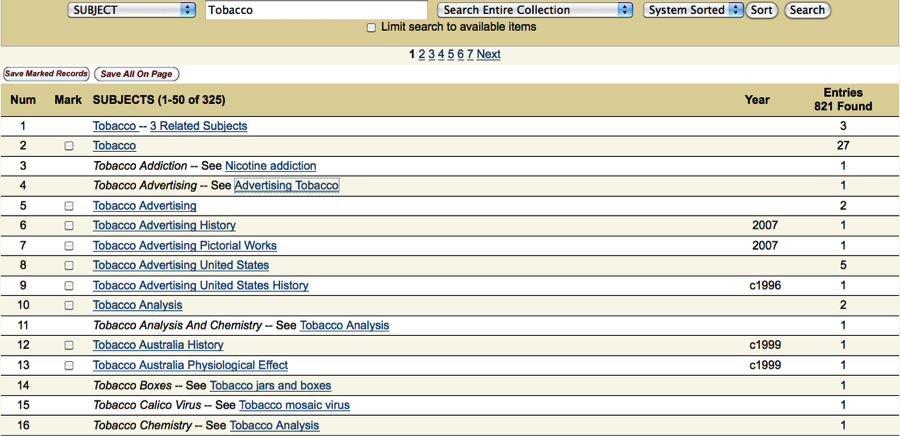
Source: MAS School – Ultra Search, EBSCO
We can see that there are 325 distinct subjects that have the word “tobacco” in them. Surely we could find something to write about if we browsed through all 325 of these subjects. However, our topic is already more specific and involves not only tobacco, but also teenagers and advertising. There are a few entries about tobacco and advertising but none about teenagers, although we know that the library has books about that topic.
Subject searches are most useful for giving you a place to start with a very broad topic. Notice that the top
entry says “3 Related Subjects.” If we clicked on that link, we would get a list of narrower subjects related to
tobacco, topics that might interest us: cigarettes, nicotine, and smokeless tobacco.
Recording your source
When you find a book to use, you will again need to record relevant information for your working bibliography. You should note the following:
- Author
- Title
- Date published
- Your impressions of the book
For the book we just discussed, I write:
- Clete Snell
- Peddling Poison: The Tobacco Industry and Kids
- 2005
- This book is very specific about the negative impact of tobacco advertising on kids. Good resource.
Now that we’ve discussed all of the types of sources you might use and how to find them, you are ready to hit the library!
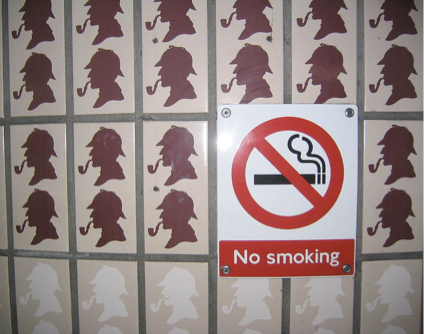
Source: Baker Street Station in London Underground, Ed G2S, Wikimedia Commons